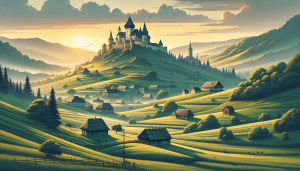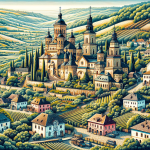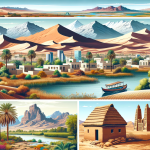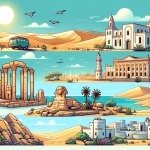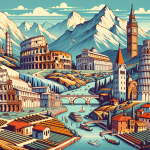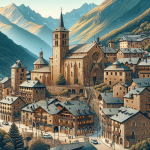Discovering the Enchantment of Romania: A Complete Travel Guide
Romania, a country often overlooked in favor of its more famous neighbors, offers a treasure trove of experiences for the intrepid traveler. Nestled in the heart of Eastern Europe, this captivating nation boasts a rich tapestry of history, stunning natural landscapes, and vibrant cultural traditions. From the mystical castles of Transylvania to the bustling streets of Bucharest, Romania invites you to explore its many facets. This guide will take you on a journey through Romania’s most iconic destinations, offering insights into its history, culture, and hidden gems. Whether you’re an adventure seeker, a history buff, or simply looking for a unique travel experience, Romania has something to offer. Let’s delve into the magic of Romania and uncover why it should be on every traveler’s bucket list.
Bucharest: The Vibrant Capital
Historical Landmarks
Bucharest, Romania’s capital, is a city that effortlessly blends the old with the new. Start your journey at the Palace of the Parliament, one of the world’s largest administrative buildings. This colossal structure, built during the communist era, offers a glimpse into Romania’s tumultuous past. Don’t miss the Romanian Athenaeum, an architectural masterpiece that hosts many of the country’s most prestigious concerts.
Cultural Experiences
Bucharest is not just about historical landmarks; it’s a hub of cultural activities. Head to the Old Town to experience the city’s vibrant nightlife and eclectic mix of bars, restaurants, and shops. For a more relaxed experience, visit Herastrau Park, where you can enjoy a boat ride on the lake or a leisurely stroll through the gardens.
Modern Attractions
In recent years, Bucharest has also embraced modernity. The National Museum of Contemporary Art and the Cotroceni Palace are must-visits for those interested in contemporary art and architecture. The city’s burgeoning tech scene and numerous co-working spaces make it a hotspot for digital nomads.
Transylvania: Land of Legends
Bran Castle
No trip to Romania is complete without a visit to Bran Castle, often referred to as Dracula’s Castle. This iconic fortress, perched on a hilltop, offers breathtaking views and a fascinating history. While the connection to Bram Stoker’s Dracula is tenuous, the castle’s eerie ambiance and rich history make it a must-visit.
Sibiu and Sighisoara
Transylvania is also home to some of Romania’s most charming medieval towns. Sibiu, with its well-preserved architecture and vibrant cultural scene, was named a European Capital of Culture in 2007. Sighisoara, the birthplace of Vlad the Impaler, offers a step back in time with its cobblestone streets and colorful houses.
Natural Wonders
Transylvania is not just about castles and medieval towns; it’s also a haven for nature lovers. The Carpathian Mountains offer numerous hiking trails, while the Hoia Forest is famous for its mysterious, paranormal activity. Whether you’re an avid hiker or simply looking to enjoy the great outdoors, Transylvania has something for everyone.
Maramures: The Land of Wooden Churches
Unique Architecture
Maramures is renowned for its unique wooden churches, many of which are UNESCO World Heritage Sites. These churches, with their tall spires and intricate wood carvings, are a testament to the region’s rich cultural heritage. Some must-visit churches include the Church of the Holy Paraskeva in Desesti and the Church of the Presentation of the Virgin in Barsana.
Traditional Villages
The region is also home to some of Romania’s most traditional villages. In places like Breb and Sapanta, you can experience the country’s rural lifestyle and rich traditions. Don’t miss the Merry Cemetery in Sapanta, where each tombstone is adorned with colorful, often humorous epitaphs.
Cultural Festivals
Maramures is a region that takes pride in its traditions and cultural heritage. Throughout the year, numerous festivals celebrate everything from traditional crafts to folk music and dance. The Festival of the Painted Eggs in Ciocanesti and the Maramures Balloon Fiesta are just a few examples of the region’s vibrant cultural calendar.
The Danube Delta: A Natural Paradise
Biodiversity
The Danube Delta, one of Europe’s most biodiverse regions, is a paradise for nature lovers. This UNESCO World Heritage Site is home to over 300 species of birds, making it a birdwatcher’s dream. The delta’s labyrinthine network of channels, lakes, and marshes offers a unique ecosystem that’s unlike any other in Europe.
Outdoor Activities
The Danube Delta is not just about birdwatching; it’s also a hub for various outdoor activities. Fishing, kayaking, and boating are popular ways to explore the delta’s waterways. For a more immersive experience, consider staying in a traditional fisherman’s cottage and taking a guided tour to learn about the local flora and fauna.
Cultural Heritage
The region is also rich in cultural heritage. The Letea Forest, with its ancient oak trees and wild horses, is a must-visit. The Lipovan and Haholi communities, descendants of Russian Old Believers, offer a glimpse into the region’s diverse cultural fabric. Don’t miss the opportunity to try local dishes like plachie de peste (fish stew) and saramura de crap (carp brine).
Bucovina: Land of Painted Monasteries
UNESCO World Heritage Sites
Bucovina is famous for its painted monasteries, many of which are UNESCO World Heritage Sites. These monasteries, adorned with intricate frescoes, offer a glimpse into Romania’s religious and artistic heritage. Voronet Monastery, often called the “Sistine Chapel of the East,” is renowned for its vivid blue frescoes, while Sucevita Monastery is famous for its intricate green and red designs.
Spiritual Retreats
For those seeking a more spiritual experience, Bucovina offers numerous retreats and pilgrimages. The Putna Monastery, founded by Stephen the Great, is a significant pilgrimage site and offers a tranquil setting for meditation and reflection. The Moldovita Monastery is another must-visit, known for its stunning architecture and serene surroundings.
Local Crafts
Bucovina is also a hub for traditional crafts. The region is famous for its painted eggs, a tradition that dates back centuries. You can visit local artisans to see how these intricate designs are created and even try your hand at egg painting. The Marginea pottery village is another highlight, where you can watch craftsmen create beautiful black ceramics using traditional techniques.
The Black Sea Coast: Sun, Sand, and History
Coastal Resorts
Romania’s Black Sea coast offers a mix of sun, sand, and history. Mamaia, often referred to as the “Pearl of the Romanian Riviera,” is the country’s most popular seaside resort. With its sandy beaches, luxury hotels, and vibrant nightlife, Mamaia is a favorite destination for both locals and tourists.
Historical Sites
For history enthusiasts, the coastal town of Constanta offers a wealth of historical sites. The Roman Mosaic Edifice and the Archaeological Museum provide fascinating insights into the region’s ancient past. The Genoese Lighthouse and Ovid Square are also worth visiting.
Natural Attractions
The Black Sea coast is not just about beaches and history; it also offers numerous natural attractions. The Danube Delta is a short drive away, making it easy to combine a beach holiday with a trip to this unique natural wonder. The Macin Mountains offer excellent hiking opportunities, while the Cheile Dobrogei gorge is a hidden gem for nature lovers.
Conclusion: Why Romania Should Be Your Next Travel Destination
Romania is a country that offers a unique blend of history, culture, and natural beauty. From the bustling streets of Bucharest to the serene landscapes of the Danube Delta, Romania has something for everyone. Whether you’re interested in exploring medieval castles, hiking in the Carpathian Mountains, or simply relaxing on the Black Sea coast, Romania promises a memorable travel experience. So pack your bags and get ready to discover the enchantment of Romania.
